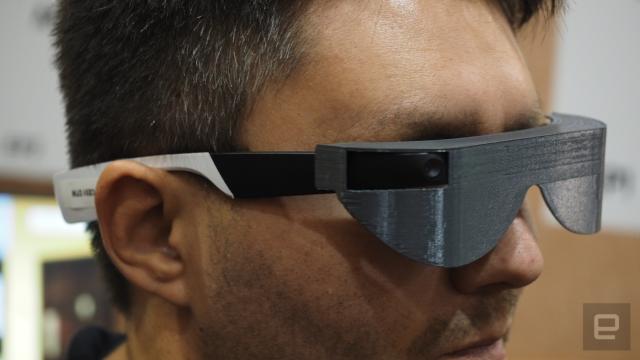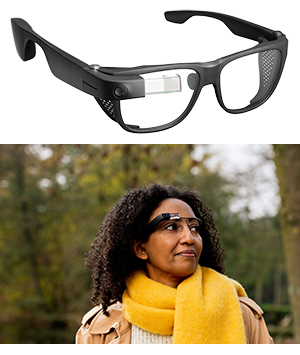Discover Advanced Assistive Gadgets for Individuals With Visual Impairments
The landscape of assistive technology for individuals with aesthetic disabilities is evolving swiftly, presenting a variety of innovative devices that boost freedom and involvement (Braille displays and notetakers). From smart glasses that seamlessly merge aesthetic input with acoustic assistance to innovative navigation applications that redefine spatial awareness, these devices are reshaping possibilities. The most current developments in Braille innovation and voice-activated systems considerably contribute to ease of access. Nonetheless, the ramifications of these advancements extend much beyond plain functionality; they challenge standard understandings of disability and freedom. What might this suggest for the future of addition and assistance?
Smart Glasses Innovations
Smart glasses stand for a considerable improvement in assistive innovation for people with aesthetic problems. These cutting-edge gadgets integrate different features designed to boost the customer's interaction with their environment. Outfitted with cams and sensors, smart glasses can record real-time aesthetic info, which is then refined and shared to the individual via audio comments or haptic sensations. This functionality permits individuals to get prompt summaries of their surroundings, improving their capacity to browse and engage with the world.
Furthermore, improvements in expert system have further improved the capabilities of smart glasses. Maker knowing formulas can identify faces, read text, and recognize items, making them very useful devices for day-to-day tasks. Users can receive auditory signs that offer context concerning their atmosphere, promoting self-reliance and confidence.
Additionally, the ergonomic layout and lightweight nature of lots of clever glasses make them ideal for extended usage, making certain comfort while improving performance. As these gadgets proceed to progress, they hold the potential to transform the means individuals with aesthetic problems experience their lives, linking the space in between availability and technology. The ongoing r & d in this field pledge to broaden the opportunities for clever glasses, making them a necessary element of modern-day assistive tools.
Navigation Apps and Equipment
Many navigating apps and devices have become important resources for individuals with aesthetic disabilities, substantially enhancing their ability to go across unfamiliar atmospheres. These innovations leverage general practitioner performance, audio hints, and real-time information to offer individuals with exact navigating help.
One prominent instance is the Aira application, which attaches users to skilled representatives who can give visual descriptions of environments and navigating assistance with a live video feed. This service improves the customer's spatial recognition and confidence while browsing. An additional remarkable device is Seeing Eye GPS, which supplies voice-guided navigating and sights, enabling users to gain access to important info regarding their surroundings.

As technology continues to advance, the development of more advanced navigation devices guarantees to further encourage people with visual problems, promoting smooth mobility and integration right into diverse settings. Such innovations are important in advertising a more comprehensive society.
Braille Modern Technology Innovations
In the last few years, advancements in Braille modern technology have substantially changed exactly how people with aesthetic problems accessibility information and involve with the globe around them. The development of mobile Braille display screens has actually reinvented analysis by allowing users to connect wirelessly to tablet computers, computer systems, and smartphones. These tools convert text into Braille in real-time, making it possible for seamless communication with electronic content.
Moreover, cutting-edge Braille printers have actually emerged, enhancing the production of tactile materials. Modern embossers are quicker and more efficient, enabling the rapid creation of Braille papers and educational products. This efficiency reduces the moment and expense connected with creating Braille resources, making them much more accessible click to institutions and companies.
In addition, the combination of Braille with other modern technologies, such as expert system and artificial intelligence, has opened new avenues for tailored understanding experiences. Voice acknowledgment and synthesis modern technologies can match Braille, offering a comprehensive technique to information dissemination.
As the need for comprehensive education and learning and workplace atmospheres grows, these technological improvements play a crucial role in encouraging individuals with visual impairments, guaranteeing they have equivalent access to information and possibilities in different elements of life.
Wearable Gadgets for Freedom
An expanding array of wearable devices is boosting independence for people with aesthetic problems, providing ingenious remedies that improve navigating and daily living. Braille displays and notetakers. These tools utilize innovative modern technologies to give real-time comments and assistance, advertising autonomy in various atmospheres

Wearable technology likewise includes smartwatches that can be set with access features, allowing customers to receive notices, track their places, and even require support with the touch of a button. Some devices incorporate fabricated intelligence to evaluate the setting, offering sound descriptions of nearby things or people.
Voice-Activated Assistive Solutions
Leveraging voice-activated assistive solutions has changed the landscape of assistance for individuals with aesthetic problems, giving hands-free communication and accessibility to a range of jobs. These innovations make use of all-natural language processing and expert system to allow users to carry out everyday tasks via straightforward voice commands.

Additionally, recent developments in voice acknowledgment accuracy have actually boosted the customer experience substantially, fitting diverse accents and speech patterns. This inclusivity makes sure that more individuals can gain from these modern technologies, promoting a higher sense of autonomy.
Final Thought
In final thought, the development of advanced assistive tools substantially improves the self-reliance and lifestyle for people with aesthetic impairments. Developments such as vision check wise glasses, navigating applications, Braille technology, wearable gadgets, and voice-activated remedies jointly cultivate an even more comprehensive atmosphere. These technologies empower customers to browse their environments with self-confidence and involve more totally with the globe, eventually promoting better availability and equivalent opportunities for people encountering aesthetic obstacles.
The landscape of assistive technology for people with visual problems is progressing swiftly, providing a range of innovative devices that boost autonomy and involvement.Smart glasses represent a significant innovation in assistive technology for people with aesthetic disabilities. As these tools my latest blog post continue to evolve, they hold the prospective to reinvent the means individuals with aesthetic disabilities experience their daily lives, linking the gap between accessibility and technology.In recent years, developments in Braille innovation have significantly changed exactly how individuals with visual problems gain access to info and engage with the world around them. These innovations empower users to navigate their surroundings with self-confidence and engage more fully with the globe, eventually advertising higher access and equivalent opportunities for people dealing with visual challenges.